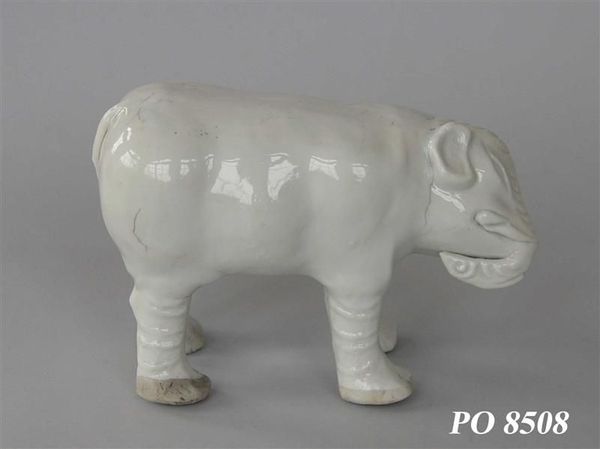Elephant, China, Dehua, Qing Dynasty (1644 - 1911), Kangxi era (1662 - 1722), 1675 - 1725
Elephant, China, Dehua, Qing Dynasty (1644 - 1911), Kangxi era (1662 - 1722), 1675 - 1725. Porcelain, without painting. H. 12.6 cm, L 18.5 cm, W. 9.6 cm. PO 8508. Porcelain Collection. © Staatliche Kunstsammlungen Dresden 2013
A pure white body with a transparent glaze is characteristic of the porcelain kilns of Dehua (Fujian Province), which is referred to in Europe as the Blanc de Chine. Originally included the collection of Augustus the Strong, more than 1200 Dehua porcelains, of which about 500 are received in the Dresden collection. Much of the "outstanding" as applicable Blanc de Chine pieces in many collections worldwide were imported by private traders to Europe. Since commissions were of higher quality than other mass-made goods, the British East India Company in 1615 already supported this business and put their employees place on ships available to drive yourself trade. Typical assignments for the European market were priests, women, dancers, lions, dogs, elephants, toys, small group presentations and Dutch families. Although there are also independent, small animal sculptures, but more often they act as a useful objects such as water dropper and incense holders on tables scholars. That it can be assumed that the potter have never seen living elephants, most representations of animals in Blanc de Chine are surprisingly naturalistic. The animal has to bear the a plump body and a slightly inclined to the right head, short snout and tusks directly.

/https%3A%2F%2Fprofilepics.canalblog.com%2Fprofilepics%2F1%2F0%2F100183.jpg)
/https%3A%2F%2Fstorage.canalblog.com%2F03%2F02%2F119589%2F96711876_o.jpg)
/https%3A%2F%2Fstorage.canalblog.com%2F11%2F31%2F119589%2F94773502_o.jpg)
/https%3A%2F%2Fstorage.canalblog.com%2F20%2F83%2F119589%2F94772815_o.jpg)
/https%3A%2F%2Fstorage.canalblog.com%2F26%2F72%2F119589%2F75604929_o.jpg)
/https%3A%2F%2Fstorage.canalblog.com%2F59%2F60%2F119589%2F26458628_o.jpg)



/http%3A%2F%2Fstorage.canalblog.com%2F79%2F84%2F119589%2F121121505_o.png)
/http%3A%2F%2Fstorage.canalblog.com%2F80%2F42%2F119589%2F120611565_o.jpg)
/http%3A%2F%2Fstorage.canalblog.com%2F79%2F49%2F119589%2F113206128_o.jpg)
/http%3A%2F%2Fstorage.canalblog.com%2F80%2F78%2F119589%2F113206111_o.jpg)